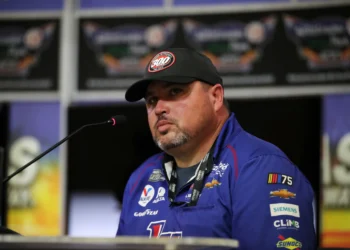When it comes to motorsports, driver numbers are more than just a form of identification—they’re part of a legacy. In Formula 1, MotoGP, and World Superbike, a driver’s number is theirs alone throughout their career. When Lewis Hamilton moved to Ferrari for 2025, he brought the iconic #44 with him. When Marc Marquez left Gresini for the Factory Ducati team, his legendary #93 stayed on his bike.
But in NASCAR, things work differently. The numbers belong to the teams, not the drivers—and that’s a system that sparks heated debate among fans.
Joe Gibbs Racing Explains the System
Joe Gibbs Racing President Dave Alpern recently broke down how the NASCAR numbering system works in a team video, explaining that NASCAR owns all the numbers and assigns them to teams.
“How do teams acquire numbers? The numbers are technically assigned to us by NASCAR. We request the number. Many teams have had the number assigned to them for decades. With the advent of charters, each charter comes with a numbered assignment, which was originally requested by the individual teams.”
So, if a driver switches teams, they can’t take their number with them. Instead, the team decides whether to continue using it, retire it temporarily, or assign a new driver to it.
A perfect example is Kyle Busch, who spent 15 years in the #18 Toyota for JGR, winning two Cup Series championships and cementing himself as a legend in that number. But when he left for Richard Childress Racing in 2023, he couldn’t take #18 with him—it stayed with JGR, though they chose to bench it.
Meanwhile, Ty Gibbs took over Busch’s seat but was assigned #54 instead. Similarly, with Martin Truex Jr. retiring after 2024, Chase Briscoe will drive the #19 Toyota in 2025, even though he raced in the #14 car at Stewart-Haas Racing.
Does This System Work? Pros and Cons
While some fans feel this approach helps preserve team identity, others argue it disconnects drivers from their legacy.
✅ Why It’s Good for NASCAR Teams:
🔹 Establishes team brands: Fans associate numbers with legendary teams, like Hendrick Motorsports’ #24 (Jeff Gordon) or Richard Petty’s iconic #43.
🔹 Charter stability: The charter system ensures long-term control over numbers, preventing constant reshuffling.
🔹 Keeps history within teams: If a driver leaves, the team retains its legacy—just like JGR still controls the #18 Busch made famous.
❌ Why It Feels Unfair to Drivers:
🔸 Disconnects drivers from their identity: Fans grew up linking certain numbers to their favorite drivers—but that history doesn’t carry over when they switch teams.
🔸 No long-term ownership for drivers: Kyle Busch couldn’t take #18, even though he made it legendary.
🔸 Lack of individual legacy: Unlike F1, NASCAR’s system prioritizes teams over drivers, making it harder for a driver’s number to become truly theirs.
The Verdict: A Unique NASCAR Tradition
Ultimately, NASCAR’s team-owned number system is unique—and controversial. While it strengthens team legacies, it also means that fans can’t always follow their favorite driver’s number.
Would NASCAR benefit from a hybrid system where certain numbers become driver-owned after a milestone (e.g., 10+ years with a team)? Or does this system reinforce the deep-rooted team rivalries that make NASCAR so unique?
One thing’s for sure—the number on a NASCAR car means more than just a digit. It’s a piece of history, whether it belongs to the driver or the team.













